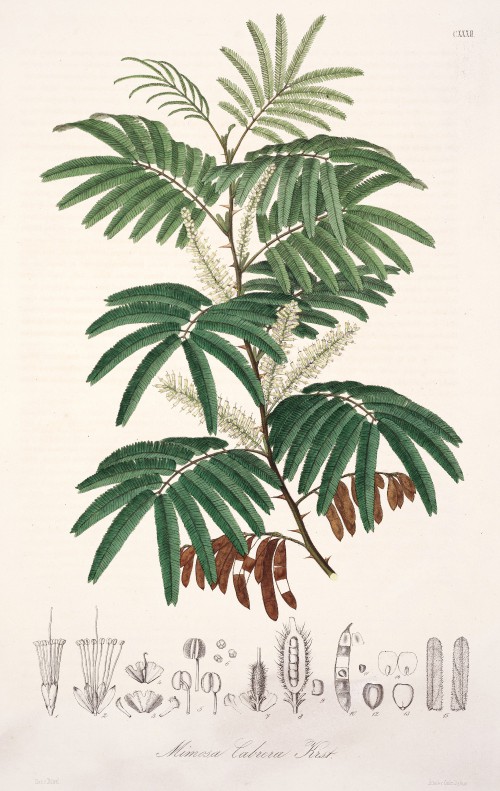Mimosa tenuiflora (Willd.) Poir. - syn. Mimosa hostilis Benth.; Mimosa cabrera H. Karst. - Mimosaceae - yurema, jurema, Jurema
Perennial evergreen shrub or tree, up to 8m high, native to tropical Central and South America (Brazil to Mexico); leaves pinnate, leaflets 10-30 pairs, up to 6mm long; flowers white, fragrant.
Besides triterpenoid glycosides (saponins) of the root bark of M. tenuiflora derived from oleanolic acid, the mimonosides A, B and C, (3-O-β-D-glucopyranosyl campesterol, 3-0-β-d-glucopyranosyl stigmasterol and 3-0-β-d-glucopyranosyl β-sitosterol), were found together with lupeol, campesterol, stigmasterol and β-sitosterol. In vitro biological tests (immunomodulation and proliferation) of mimonosides using different animal and human cells in culture shwoed effects which may contribute to explain the traditional use of this plant material in folk medicine to promote damaged skin growth.
[Triterpenoid glycosides from the bark of Mimosa tenuiflora., Jiang, Y., Massiot, G., Lavaud, C., Teulon, J. M., Guéchot, C., Haag-Berrurier, M., Anton, R., Phytochemistry, 30(7), 1991, 2357-2360]
[Pharmacognosy of Mimosa tenuiflora (willd.) poiret., Anton, R., Jiang, Y., Weniger, B., Beck, J.P., Rivier, L., Journal of ethnopharmacology, 38(2), 1993, 145-152]
The tannin-rich bark is wrinkled, reddish-brown to grey, with fibrous texture, 0.5-1.5 mm thick, resinous and with an astringent odor and flavor. Preparations (bark tea, powder and/or ointment) are used against skin wounds and burns - diverse products, such as shampoos, creams, capsules, soaps, etc., are commercialized.
[Descripción, distribución, anatomía, composición química y usos de Mimosa tenuiflora (Fabaceae-Mimosoideae) en México., Camargo-Ricalde, S.L., Revista de Biología tropical, 48(4), 2000, 939-954]
„The bark of the Mimosa tenuiflora (Willd.) Poiret (Leguminoseae) tree, known as tepescohuite in Mexico, is commonly used in this country and in Central America to elaborate different products for the treatment of skin burns and lesions. The cicatrizing properties of extracts obtained from this bark have been scientifically studied, attributing the main biological activity to its tannin and saponin content. Studies include clinical trials of phytodrugs based on Mimosae tenuiflora bark extracts for treatment of venous leg ulcerations… The chemical studies performed demonstrated that tannins represent the major component group in the bark. Its content in genuine tepescohuite is 16% and is mainly composed of proanthocyanidins, a condition permitting a tannin-based chemical-control method for fingerprinting the plant drug. Contrariwise, the saponin concentration in Mimosae tenuiflora bark is extremely low…“
[Pharmacognostical studies of the plant drug Mimosae tenuiflorae cortex., Rivera-Arce, E., Gattuso, M., Alvarado, R., Zárate, E., Agüero, J., Feria, I., Lozoya, X., Journal of ethnopharmacology, 113(3), 2007, 400-408]
As the bark of Mimosa tenuiflora is utilized in folk medicine of Mexico for the treatment of skin lesions, a randomized, double-blind, placebo-controlled clinical trial was conducted to evaluate the therapeutic effectiveness. One group received a hydrogel containing 5% of a crude extract standardized in its tannin concentration (1.8%), while the control group, was administered the same hydrogel but without addition of the extract. „… Follow-up lasted 13 weeks and ulcer healing was determined through measurement of the lesion area by digital-photographic parameters. Therapeutic effectiveness occurred in all patients of the extract group; after the 8th treatment week, ulcer size was reduced by 92% as mean value in this group, whereas therapeutic effectiveness was observed only in one patient of the control group (χ2, p = 0.0001). No side effects were observed in any patient in either group.“
[Therapeutic effectiveness of a Mimosa tenuiflora cortex extract in venous leg ulceration treatment., Rivera-Arce, E., Chavez-Soto, M.A., Herrera-Arellano, A., Arzate, S., Agüero, J., Feria-Romero, I.A., Lozoya, X., Journal of ethnopharmacology, 109(3), 523-528.]
„Yurema is the name of a plant, a deity, certain geographical areas and a sacramental beverage that is made from the root bark of Mimosa tenuiflora (Willd.) Poir. This species may be identical to Mimosa hostilis
(Mart.) Benth. The beverage, as jurema preta, vinho da jurema and other names, is still used by people of Northeastern Brazil for medico-religious purposes, and may contain other plant additives… Yurema is still used for its psychoactive properties in traditional religions of Brazil. However, a pharmacological explanation for the visionary effects from this sacred beverage is lacking, as DMT is not orally active because of its rapid enzymatic metabolism by MAO. Ayahuasca, another sacred visionary beverage from Brazil, typically contains DMT (from the leaves of Psychotria viridis) but another plant is required to render DMT orally active; Banisteriopsis caapi, which contains the potent MAO inhibitor harmine.“
The indole alkaloids N,N-dimethyltryptamine (DMT) and yuremamine were isolated from the stem bark of Mimosa tenuiflora.
[Isolation and Characterization of Yuremamine, a New Phytoindole., Vepsäläinen, J.J., Auriola, S., Tukiainen, M., Planta Med, 71, 2005, 1053-1057]
„… β-carbolines, which could be formed endogenously from the basic tryptamines such as 5-hydroxy-tryptamine (serotonine) (Calaway, 1988; Calaway, 1994), were found in M. tenuiflora (Meckes-Lozoya et al., 1990a). The presence of these substances can result in MAO inhibition, which may lead to an increase in the amount of catecholamine in the central nervous system, provoking euphoric effects (Corbett, 1977). According to Ott (2002), there may be MAO inhibitors in the „jurema preta“ extract, which would explain the observed effects. Nevertheless, the „jurema wine“ is potentially visionary per se. The inactivity of some preparations, might be due to insufficient dosage. Experimental studies are necessary to test this hypothesis.“
[Jurema-Preta (Mimosa tenuiflora [Willd.] Poir.): a Review of its Traditional Use, Phytochemistry and Pharmacology., de Souza, R.S.O., de Albuquerque, U.P., Marcelino, J., Braz. arch. biol. technol, 51(5), 2008, 937-947]
Determination of N,N-dimethyltryptamine (DMT) in Mimosa tenuiflora inner bark with matrix solid-phase dispersion (MSPD) and GC-MS showed values from 1.2 to 9.3 mg/g.
[Determination of N, N-dimethyltryptamine in Mimosa tenuiflora inner barks by matrix solid-phase dispersion procedure and GC-MS., Gaujac, A., Aquino, A., Navickiene, S., De Andrade, J.B., Journal of Chromatography B, 881, 2012, 107-110]

Mimosa tenuiflora Benth. as Mimosa cabrera Karsten; Karsten, K.W.G.H., Florae Columbiae, vol.2 t.132 (1869)
http://plantgenera.org/species.php?id_species=673433